The iPhone 7 and iPhone 7 Plus Review: Iterating on a Flagship
by Joshua Ho & Brandon Chester on October 10, 2016 8:00 AM EST- Posted in
- Smartphones
- Apple
- Mobile
- iOS
- iOS 10
- iPhone 7
- iPhone 7 Plus
System Performance
Section by Brandon Chester
At the heart of a smartphone lies the SoC. While there's now an increasingly common belief that specifications don't matter, the truth of the matter is that almost all of the software features that users now take for granted in a smartphone have only been made possible by the continued improvements in hardware performance. Modern smartphones with high resolution displays and complex interfaces would not exist if the available CPU and GPU processing power hadn't advanced as much as it has. On top of that, performance is something of a gating factor for software development, as the innovation that happens in software has to happen within the boundaries of what can be done with the hardware. Specifications in a smartphone actually matter quite a lot, even if the user isn't actively aware of all the individual components that make up their smartphone's SoC.
With the iPhone 7 Apple doesn't have the benefit of a new major process node to help improve performance. Any improvements will be the result of architectural improvements, as well as improvements that have been made to TSMC's 16nm process since the release of the Apple A9, which was Apple's first FinFET SoC. It's important to note that one of the goals of A10 Fusion is improving dynamic range, so the focus isn't solely on improving performance. However, device performance seemingly must improve with each generation, and Apple is advertising a 40% improvement in CPU performance and a 50% improvement in GPU performance with A10 Fusion compared to A9.
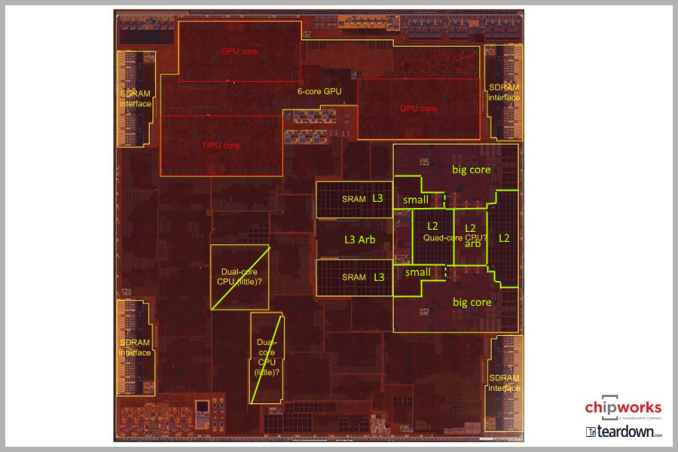
A10 Fusion's Floorplan (Special thanks to Chipworks)
While an in-depth look at A10 Fusion will have to wait until our seperate technology deep dive, we can still take a look at how performance has changed at a higher level. A10 Fusion's peak frequency is 2.3GHz, up from 1.8GHz on A9. This gives a theoretical improvement of 28% on its own, and the remainder will have to come from improvements to the architecture in Apple's (big) Hurricane cores. Based on our testing so far, Hurricane is not radically different from Twister (A9), but Apple has been making some optimizations. Meanwhile it should be noted that while A10 technically has four CPU cores – the two Hurricane cores and the two smaller cores – this is not a heterogeneous design, and only two cores are active at once. So for the purposes of high performance benchmarking, this means we're benchmarking the big cores nearly exclusively.
Anyhow, we've run our standard suite of benchmarks on the iPhone 7 and 7 Plus to see if A10 Fusion stands up Apple's performance claims.
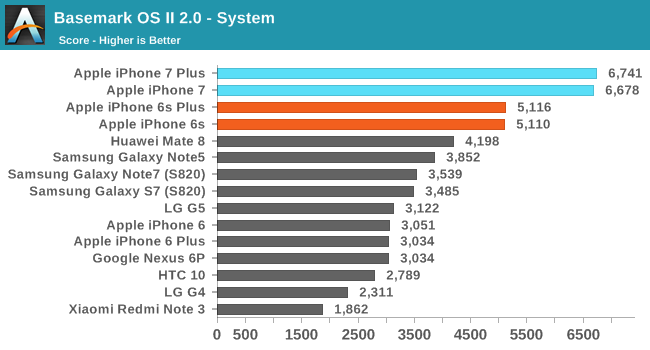
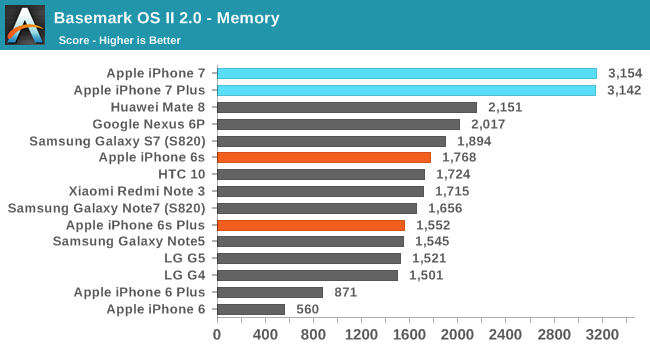
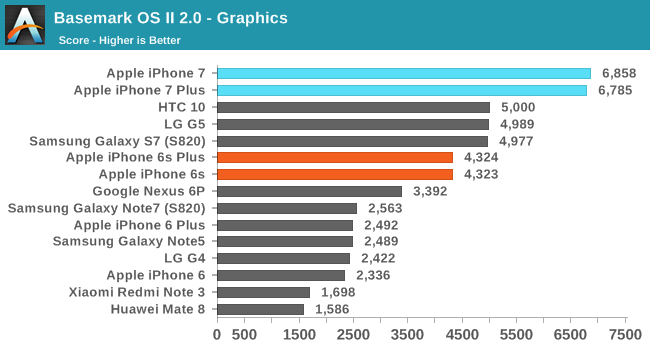
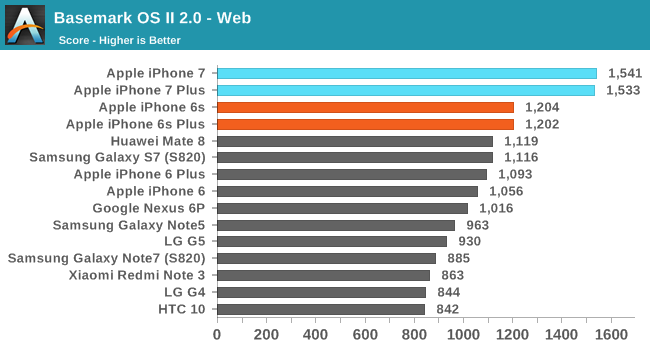

I've brought back BaseMark OS II for this review, although unfortunately the reason has less to do with wanting it back in the benchmark suite and more to do with there being very few cross-platform general system benchmarks nowadays. You can focus on the GPU, or the CPU, but the major system performance benchmark in mobile is PCMark and it remains exclusive to Android. BaseMark OS II is a pretty large optimization target now, and while it does test many aspects of the system it doesn't do so by directly simulating the tasks that a user would perform. Despite that, it helps in getting a holistic view of a device's performance by going beyond tests of a single component, so it's not without its uses.
The iPhone 6s and 6s Plus have remained the fastest overall devices in this test, so it's really just a matter of seeing how much Apple has improved. The latest generation of Android devices outpaced the GPU performance Apple's A9 SoC some time ago, so that's one area where Apple could stand to improve against the competition. As it turns out, they have. The iPhone 7 and 7 Plus show significant gains over their predecessors across the board. Performance in the system sub-test is up by 25-30%, and the graphics score is right in line with Apple's claimed 50% increase in performance. Web shows similar gains to system, which makes sense given that both are relatively CPU-bound.
The memory/storage test also shows a large improvement, which is interesting at first glance given that Apple didn't highlight any improvements in this area. However, this is just the result of the tested units being the 256GB model. On my retail iPhone 7 which is 128GB the memory score is essentially the same as the iPhone 6s which was also tested in a 128GB configuration. This comes down to the fact that these devices use a hybrid SLC/TLC storage solution, where the SLC storage can be used for writes and data can be moved later as needed. It's likely that on the 128GB iPhones the BaseMark OS II memory test is exceeding the size of the SLC cache, leading to lower scores based on the performance of the TLC NAND. On the 256GB iPhone the SLC cache is large enough to fit the entire data set used in the test, leading to a much higher score.
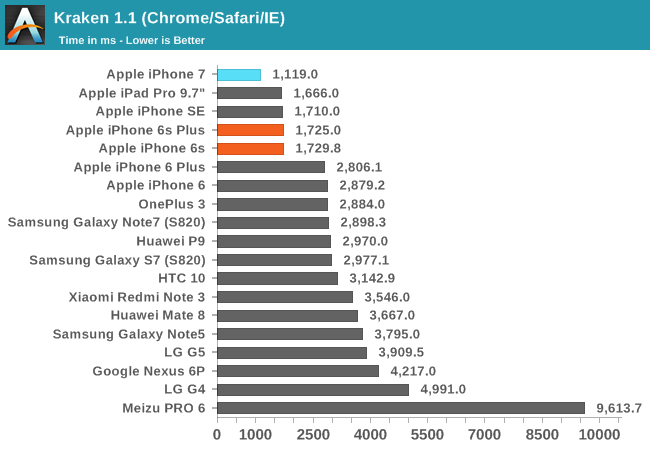
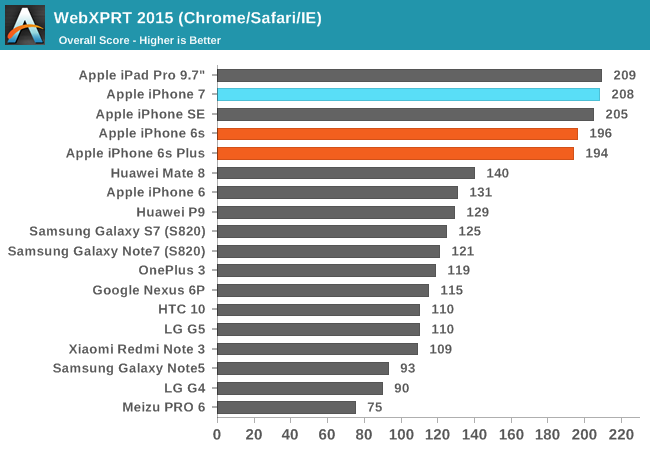
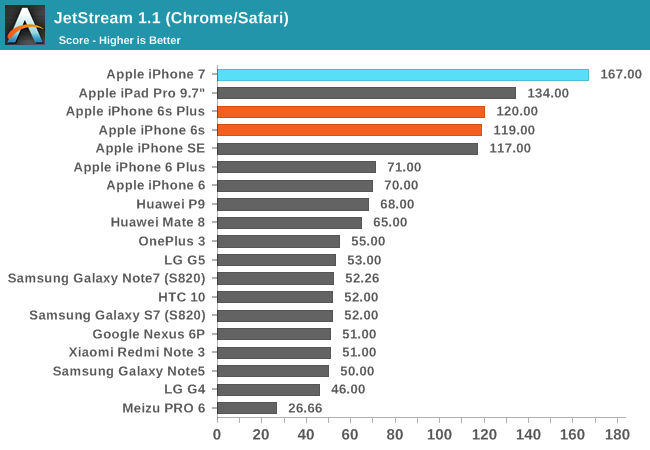
Web performance is an interesting case. While Apple's continued increases in single core CPU performance have benefited web performance with each generation, the truth is that improvements Mobile Safari's Nitro JavaScript engine have contributed a great deal as well. When looking at the charts you can see that there's a significant gap between the iPhone 7 and the next device, with the exception of WebXPRT where it's tied. What's more important than this gap is what the second device actually is. It's always another Apple device, and the same is true for the third device, and the fourth device, and so on. In Kraken and Jetstream the top seven devices on the chart are Apple's mobile devices, and the charts only have seven Apple devices in total. The Huawei Mate 8 is able to move ahead of the iPhone 6 in WebXPRT, but the gap between it and the iPhone 6s is still enormous. While Apple has continued to advance their web performance, it hasn't been with the immediate goal of beating the Android competition, as the best Android devices are still just trading blows with the iPhone 6.
WebXPRT is a small exception. As far as mobile benchmarks go, it's quite long and has short bursty workloads with pauses between each to simulate how a user would pause between different actions while using the browser. I suspect that in this case we're seeing the effects of A10 switching between its low power and high performance cores, causing parts of the test to be run on the little cores, which are not as performant. In fact, In the case of very quick actions that take only tenths or hundreths of a second to complete, it may not be possible to switch to the high performance cores before the operation has ended, causing the score to reflect the performance of the low power cores instead.
While it might seem reasonable to attribute the superior web performance of iOS devices to Apple's focus on improving single threaded CPU performance, the fact that Android devices with Cortex A72 CPUs are only matching Apple's A8 SoC shows that the gap is not only due to the CPU power available. Chrome's generally poor performance on Android is a significant limiting factor, and you can see in the chart how the improvement in Android device CPU performance over time has not translated into anything close to the sorts of gains that Apple has seen in the same period. While there are customized versions of Chromium like Snapdragon Browser that provide optimizations for a class of SoCs, it doesn't look like the gap between Android devices running Chrome and iOS devices running Mobile Safari is going to close any time soon, and if anything, it's only widening with each year.


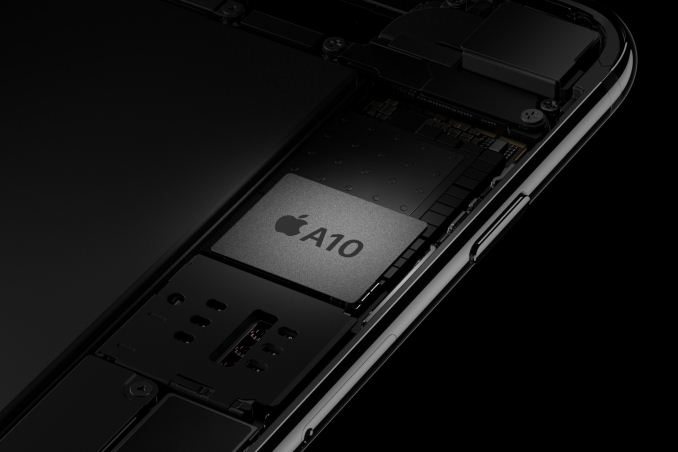








377 Comments
View All Comments
solipsism - Monday, October 10, 2016 - link
I'n the opposite of mkaibear. I prefer my iPhone but I have nothing against Android, WinPhone, or OEMs building devices for those OSes.I'm also glad to know what he uses and prefers. Wouldn't you want to know that I used an iPhone if I was reviewing an Android-based device?
You can tell Brandon goes out of his way to be objective in his writing, even when decisions are somewhat opinion-based. This is not a gift that I see too often, so I appreciate it when I do.
mjh483 - Monday, October 10, 2016 - link
Simple. Android vs iOS. Android can do things that iOS simply can't.Just because Android provides features that he needs doesn't mean he can't appreciate iOS.
I think everyone needs to read the review carefully, because it's not like he is praising everything. He DID criticise the low resolution of the Retina display.
And he gave logical reasons for things that he is impressed about. If you wanna refute that, then it's only right for you to come up with your own logical reasoning to back it up.
Infy2 - Monday, October 10, 2016 - link
I am interested in the color space of the jpgs the camera produces, since the phone itself shows them in wider than sRGB. How will the jpgs be shown by color space aware programs and "normal" programs, like web browsers, that dont know anything about color profiles or color management?Infy2 - Monday, October 10, 2016 - link
Digging up shows the jpgs show color space as "[EXIF] ColorSpace: Uncalibrated" but they have embedded ICC P3 color space profile. Viewing the jpgs on Windows 10 with uncalibrated sRGB monitor (manufacturer's stock ICC profile installed though) shows very small difference in color intensity between color managed and non-color managed programs. Overall I dont see it as big issue that the world's most popular camera phone produces images in non-sRGB color space.bw13121 - Monday, October 10, 2016 - link
I'm hoping the deep-dive includes a section on the choice of modems. Whether the Intel or Qualcomm radios- the process technology, signal performance, power consumption and a list of supported radio bands themselves. There have been rumours that the Qualcomm radio in the non EU countries is on a newer process and supports more bands? Also, it is Cat 12 Vs Cat 10 Intel XMM7360.Thoughts anyone?
jlabelle2 - Wednesday, October 12, 2016 - link
It makes little sense. Either the P3 ICC profile is embedded in the JPEG and only color profile aware software can show them properly (so very little on a Windows PC, and none on an Android or Windows phone) or it is not and the pictures will appear under saturated everywhere but some Apple devices / apps.grayson_carr - Monday, October 10, 2016 - link
Not sure about other browsers, but Safari supports proper color management and will display jpegs in their proper color space. I did notice that viewing iPhone 7 photos on an Android device makes them look far worse though because Android devices compress everything down to fit inside sRGB, making iPhone 7 photos look undersaturated on Android phones.jlabelle2 - Wednesday, October 12, 2016 - link
Yes but this is quite an exception. IE or Chrome or Edge for instance does not support reading the ICC profile of embedded image. Same for most software or app and same for ALL Android and Windows Mobile apps.Android is not "compressing anything". It just pass the RGB value to the screen.
On a aRGB or P3 JPEG, a 100,0,0 pixel represents a more satured red than a 100,0,0 in sRGB color space.
So if you display on a sRGB screen, without color management transforming the value to an equivalent one on the smaller color space, the colors will be displayed logically much less saturated.
I ask already this question to Brandon on the iPad Pro review but never get answer on this very practical question. He mentioned future proof but TODAY, if really the pictures of the iPhone 7 are taken in a wider color space than sRGB, it is a big BIG issue as it means that you cannot basically share it to almost anyone (on 93% of Windows PC and Chromebook, on 85% of the mobile phones) because it will not be displayed properly.
It seems so counterproductive that I have no idea why Apple would do that except to try cheating people making them believe of the advantage of their wider color gamut screen while the difference is mostly due to the color management issue (almost no real life pictures go beyond sRGB gamut).
Constructor - Monday, October 17, 2016 - link
The way it should be working is this:• The camera shoots the picture in P3 color space and attaches the appropriate P3 profile to the picture, so any color-managed software knows precisely what the colors are supposed to look like.
• On a display with a smaller color space the image color space will have to be compressed into the smaller space – you cannot see the colors as they actually were but only a less saturated, incorrect image but it will be fit into the smaller space as well as possible if color management is present, for instance preserving the color balance even if the display is just weak in blues or reds. If no color management is present, the image can become discolored on top of the compression, depending on the exact limitations of the display.
• On a display with full P3 color space you see the colors from the P3 photo precisely as they actually were, exploiting the full gamut.
• With a photo coming from a smaller color space such as sRGB, the color-managed P3 display would display this photo as it is supposed to look like, namely with its sRGB colors.
• Without color management the gamut would simply be blown up to full P3 gamut, incorrectly oversaturating the image.
jlabelle2 - Monday, October 24, 2016 - link
"The way it should be working is this:"Well less and no. You are totally CORRECT on the behavior today: it seems to have been confirmed that the JPEG have the DCI-P3 color space embedded but I have not be able to find some iPhone 7 images that did not have sRGB instead...
So if this is the case, it means, exactly as you said that basically more than 85% of the population (all Android and Windows PC/laptop/tablet users) will see the image wrong, desaturated because of the smaller gamut of their screen.
Saying that what it should do is to implement it so that you can NOT share it with 86%+ of the population is ... weird.
What Apple could have done is to let the user select this in the settings like every camera able to capture wider gamut than sRGB do. But no. It is Apple. So for the excuse of making things simple, they screw up the very vast majority of the population.
The fact that it can be put by Anandtech in any positive way is really puzzling. Anand would have had better knowledge than that but he is not here anymore.